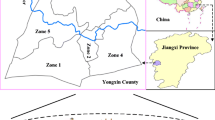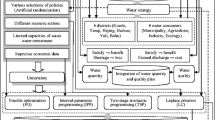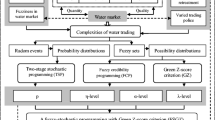Abstract
In this study, a risk-based balance inexact water resources optimization model for considering wetland ecological water demand and water quality problems, based on interval-parameter programming, fuzzy two-stage stochastic programming, and downside risk-aversion measure, is developed for regional water resources management in Nansihu Lake basin, Shangdong province, China. The developed model can tackle uncertainties described in terms of interval values and probability distributions. Moreover, risk aversion is incorporated by limiting the volatility of the expected profit through downside risk methodology, in order to limit the risk of failing to reach an income target of competitive regions in the lake basin and reflect the preference of decision makers, such that the tradeoff between system economy, ecological water demand, and income target could be analyzed. All suggested scenarios (e.g. the plausibility degree of ecological water demand and the risk level of unbalance income) are determined by management requirement. The results indicated that different water inflow and ecological-related water demand levels correspond to different water shortages and allocation schemes of different water sources, and thus lead to varied system benefit and system-failure risk. The proposed model is valuable for supporting mid-/long-term water resources management under economic, environmental, ecological, and system balance development considerations.







Similar content being viewed by others
References
Ahmed S, Cakmak U, Shapiro A (2007) Coherent risk measures in inventory problems. Eur J Oper Res 182:226–238
Bean JC, Higle JL, Smith RL (1992) Capacity expansion under stochastic demands. Oper Res 40(2):210–216
Birge JR, Louveaux FV (1997) Introduction to Stochastic Programming. Springer, New York
Brinson G, Hood R, Beebower G (1986) Determinants of portfolio performance. Financ Anal J 42(4):39–48
Bunch MJ, Morrison KE, Parkes MW, Venema HD (2011) Promoting health and well-being by managing for social-ecological resilience: the potential of integrating ecohealth and water resources management approaches. Ecol Soc 16(1):1–18
Dubois D, Prade H (1989) Fuzzy sets, probability and measurement. Eur J Oper Res 40:135–154
Faye RM, Sawadogo S, Lishoua C, Mora-Camino F (2003) Long-term fuzzy management of water resource systems. Appl Math Comput 137:459–475
Finger R (2013) Expanding risk consideration in integrated models - the role of downside risk aversion in irrigation decisions. Environ Model Softw 43:169–172
Freeman RC, Bell KP, Calhoun AJK, Loftin CS (2012) Incorporating economic models into seasonal pool conservation planning. Wetlands 32:509–520
Guo P, Huang GH, Zhu H, Wang XL (2010) A two-stage programming approach for water resources management under randomness and fuzziness. J Environ Model Softw 25(12):1573–1581
Harrison ME (2013) Using conceptual models to understand ecosystem function and impacts of human activities in tropical peat-swamp forests. Wetlands 33:257–267
HRC (The Huaihe river Commission of the Ministry of water resources, P.R.C) (2011) Huaihe river basin and Shangdong peninsula integrated water resources plan
Hu XL, Motvvani JG (2014) Minimizing downside risks for global sourcing under price-sensitive stochastic demand, exchange rate uncertainties, and supplier capacity constraints. Int J Prod Econ 147:398–409
Huang GH (1996) IPWM: an interval-parameter water quality management model. Eng Optim 26:79–103
Huang GH, Loucks DP (2000) An inexact two-stage stochastic programming model for water resources management under uncertainty. Civ Eng Environ Syst 17:95–118
Huang GH, Baetz BW, Patry GG (1992) An interval linear programming approach for municipal solid waste management planning under uncertainty. Civ Eng Environ Syst 9:319–335
Kauffman-Axlrod JL, Steinberg SJ (2010) Development and application of an automated GIS based evaluation to prioritize wetland restoration opportunities. Wetlands 30:437–448
Kingsford RT (2000) Ecological impacts of dams, water diversions and river management on floodplain wetlands in Australia. Aust Ecol 25(2):109–127
Ling AF, Sun J, Yang XG (2014) Robust tracking error portfolio selection with worst-case downside risk measures. J Econ Dyn Control 39:178–207
Lv Y, Huang GH, Sun W (2013) A solution to the water resources crisis in wetlands: development of a scenario-based modeling approach with uncertain features. Sci Total Environ 442:515–526
Maqsood I, Huang GH, Huang YF, Chen B (2005a) ITOM: an interval-parameter two-stage optimization model for stochastic planning of water resources systems. Stoch Env Res Risk A 19:125–133
Maqsood I, Huang GH, Yeomans JS (2005b) An interval-parameter fuzzy two-stage stochastic program for water resources management under uncertainty. Eur J Oper Res 167:208–225
Qin XS, Huang GH, Chen B, Zhang BY (2009) An interval-parameter waste-load-allocation model for river water quality management under uncertainty. Environ Manag 43:999–1012
Sun ZP, Wei B, Su W, Shen WM, Wang CZ, You DA, Liu Z (2011) Evapotranspiration estimation based on the SEBAL model in the Nansi Lake Wetland of China. Math Comput Model 54:1086–1092
Xie YL, Huang GH (2013) An optimization model for water resources allocation risk analysis under uncertainty. J Hydroinf 16(1):144–164
Xie YL, Huang GH (2014) Development of an inexact two-stage stochastic model with downside risk control for water quality management and decision analysis under uncertainty. Stoch Env Res Risk A 28(6):1555–15575
Zhang LX, Ulgiati S, Yang ZF, Chen B (2011) Emergy evaluation and economic analysis of three wetland fish farming systems in Nansi Lake area, China. J Environ Manag 92:683–694
Acknowledgments
This research was supported by National Basic Research Program of China, Grant No. 2013CB430401, and the Fundamental Research Funds for the Central Universities (13XS20), and the Major Project Program of the Natural Sciences Foundation (51190095). The authors are extremely grateful to the editor and the anonymous reviewers for their insightful comments and suggestions.
Author information
Authors and Affiliations
Corresponding author
Appendix
Appendix
t | Planning period, t = 1 for the planning period of 2015 to 2019, t = 2 for the planning period of 2020 to 2024 | k | Planning region, k = 1, 2, 3 and 4 for Jining, Zaozhuang, Heze District, and Xuzhou District |
i | Public water sources, i = 1 and 2 for surface water of the Lake Basin and Yellow River | j | Independent water source, j = 1 and 2 for surface water and ground water resources. |
h | Water inflow level of Nansihu Lake, h = 1, 2, 3, 4 and 5 for low, low-medium, medium, medium-high, and high level, respectively | s | Water inflow level of Yellow River, s = 1, 2, 3, 4 and 5 for low, low-medium, medium, medium-high, and high level, respectively |
r | Water user, r = 1, 2, 3, and 4 for industrial, agricultural, municipal and environmental sectors | n | Water pollutant, r = 1 and 2 for COD and NH3-N |
L t | Length of planning period | p h | Water inflow’s probability of Nansihu Lake |
p s | Water inflow’s probability of Yellow River | W ± krit | Water supply target from public water sources (106 m3/year) |
Q ± krhst | Water shortage under h and s inflow level (106 m3/year) | IWS ± krjt | Water supply for user r from independent water sources (106 m3/year) |
YW ± krt | Water diverted from Yangtze River for user r in region k (106 m3/year) | RW ± krt | Recycle water supply (106 m3/year) |
NB ± krt | Benefit of per water consumption (106RMB¥/106 m3) | CIN ± krt | Reduction of net benefit to user r per unit of water not delivered (106RMB¥/106 m3) |
CRW ± krt | Cost of reused water treatment and supply (106RMB¥/106 m3) | CWWT ± krt | Cost of wastewater treatment (106RMB¥/106 m3) |
ξ ± krt | Recycling rate of wastewater | β ± krt | Concentrated wastewater treatment rate |
DRisk ± kt | Downside risk of each region | λ | Weight coefficient |
AWT ±1h | Available water resources capacity of Nansihu Lake (106 m3/year) | TWP ±2s | Available water resources capacity of Yellow River (106 m3/year) |
TWP ±1h | Amount of water resources of Nansihu Lake (106 m3/year) | \( {\tilde{EWD}}_{\alpha}^{\pm } \) | Wetland ecological-related water demand (106 m3/year) |
ARW ± t | Effective precipitation (106 m3/year) | DW ± krt | Water demand (106 m3/year) |
TWI ± kjt | Available water resources of independent water sources (106 m3/year) | TWY ± t | Available water resources diverted from Yangtze River (106 m3/year) |
SWT ± kt | Wastewater treatment capacity (106 m3/year) | γ ± krt | Wastewater discharge of per water consumption (106 m3/106 m3) |
CRT ± kt | Capacity of wastewater reuses treatment (106 m3/year) | MRW ± kt | Capacity of municipal water reuses treatment (106 m3/year) |
EC ± rnt | Pollutant concentration in treated wastewater (tonne/106 m3) | SC ± rnt | Pollutant concentration in untreated wastewater (tonne/106 m3) |
APE ± knt | Allowable emission amount of pollutant n in each region (tonne/year) | TPE ± nt | Allowable emission amount of pollutant in the basin (tonne/year) |
SNI ± khst | Net benefit of each region (106RMB¥) | Ω ± kt | Income target of each region (106RMB¥) |
Delta ± khst | Positive deviation from the profit target and scenario income (106RMB¥) | ||
Rights and permissions
About this article
Cite this article
Xie, Y., Huang, G., Li, W. et al. A Risk-Based Balance Inexact Optimization Model for Water Quality Management with Sustainable Wetland System Development—A Case Study of North China. Wetlands 36 (Suppl 1), 205–222 (2016). https://doi.org/10.1007/s13157-014-0604-4
Received:
Accepted:
Published:
Issue Date:
DOI: https://doi.org/10.1007/s13157-014-0604-4




